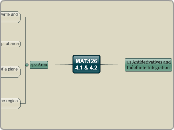by David Kedrowski 14 years ago
300
MAT.126 4.1 & 4.2
Sigma notation provides a concise way to express the sum of a series of terms, where the sum of n terms is represented with specific upper and lower bounds and an index of summation.

by David Kedrowski 14 years ago
300

More like this
Let f be continuous and nonnegative on the interval [a,b]. The area of the region bounded by the graph of f, the x-axis, and the vertical lines x=a and x=b is
Area = lim_{n --> infinity} E_{i=1}^n f(c_i) * delta x
where x_{i-1} <= c_i <= x_i and delta x = (b - a) / n.
Let f be continuous and nonnegative on the interval [a,b]. The limits as n approaches infinity of both the lower and upper sums exist and are equal to each other.
Subdivide the interval [a,b] into n subintervals each of width delta x = (b - a) / n.
The endpoints of the intervals can be defined as x_i = a + i * delta x, where i is the sequence of integers from 0 to n.
We take f to be continuous on [a,b]. Therefore the Extreme Value Theorem applies on the interval [a,b] as well as any subinterval of [a,b].
From the Extreme Value Theorem we know each subinterval has a minimum, f(m_i), and a maximum, f(M_i).
Define an inscribed rectangle inside each subregion of height f(m_i). The sum of these rectangles is called a lower sum, which we write as s(n)=E_{i=1}^n f(m_i) * delta x.
Define a circumscribed rectangle extending outside each subregion of height f(M_i). The sum of these rectangles is called an upper sum, which we write as S(n)=E_{i=1}^n f(M_i) * delta x.
Since we know the area of the region is bounded by the lower sum and the upper sum, we can write
s(n) <= area of region <= S(n)
Subdivide the interval [a,b] into n subintervals of equal size.
Define an inscribed rectangle inside each subregion. The sum of these rectangles is called a lower sum.
Define a circumscribed rectangle extending outside each subregion. The sum of these rectangles is called an upper sum.
The area of the region lies somewhere between the lower sum and the upper sum. That is, the area has been bounded.
A limiting process can be used to "squeeze" the value of the area exactly.
The second of the two classic problems from the origins of calculus.
Limiting process by which the area is "squeezed" between an upper bound and a lower bound.
Break them up into triangles.
Can be found by creating a rectangle whose area is twice that of the triangle.
Defined to be A = bh.
See page 260 in the text.
Sigma notation is a concise mathematical notation for sums.
The sum of n terms a_1, a_2, a_3, . . ., a_n is written as
E_{i=1}^n a_i = a_1 + a_2 + a_3 +...+ a_n
where i is the index of summation, a_i is the ith term of the sum, and the upper and lower bounds of summation are n and 1.
A particular solution for a differential equation is one in which the constant of integration can be specifically determined.
To find a particular solution, one must have both the general solution and the value of F(x) for one given value of x, sometimes called an initial condition (assuming you're dealing with a first order differential equation).
See the list on page 250 in the text.
The operation of finding all solutions to an equation in differential form is called antidifferentiation.
Given the differential equation
dy/dx = f(x),
multiplying both sides by dx gives the differential form of the equation,
dy = f(x) dx.
A synonym for antidifferentiation is indefinite integration.
The notation y = S f(x) dx = F(x) + C, reads "y equals the antiderivative of f with respect to x, which is equal to the antiderivative of f(x) plus a constant of integration, C."
The constant C is called the constant of integration.
The family of functions represented by G is the general antiderivative of f.
G(x) = x^2 + C is the general solution of the differential equation G'(x) = 2x, where a differential equation in x and y is an equation that involves x, y, and derivatives of y.
Given f(x) = 2x, the family of all antiderivatives of f is given by G(x) = x^2 + C.
If F is an antiderivative of f on an interval I, then G is an antiderivative of f on the interval I if and only if G is of the form G(x) = F(x) + C, for all x in I where C is a constant.
A function F is an antiderivative of f on an interval I if F'(x) = f(x) for all x in I.
Note the use of the word "an" instead of "the".